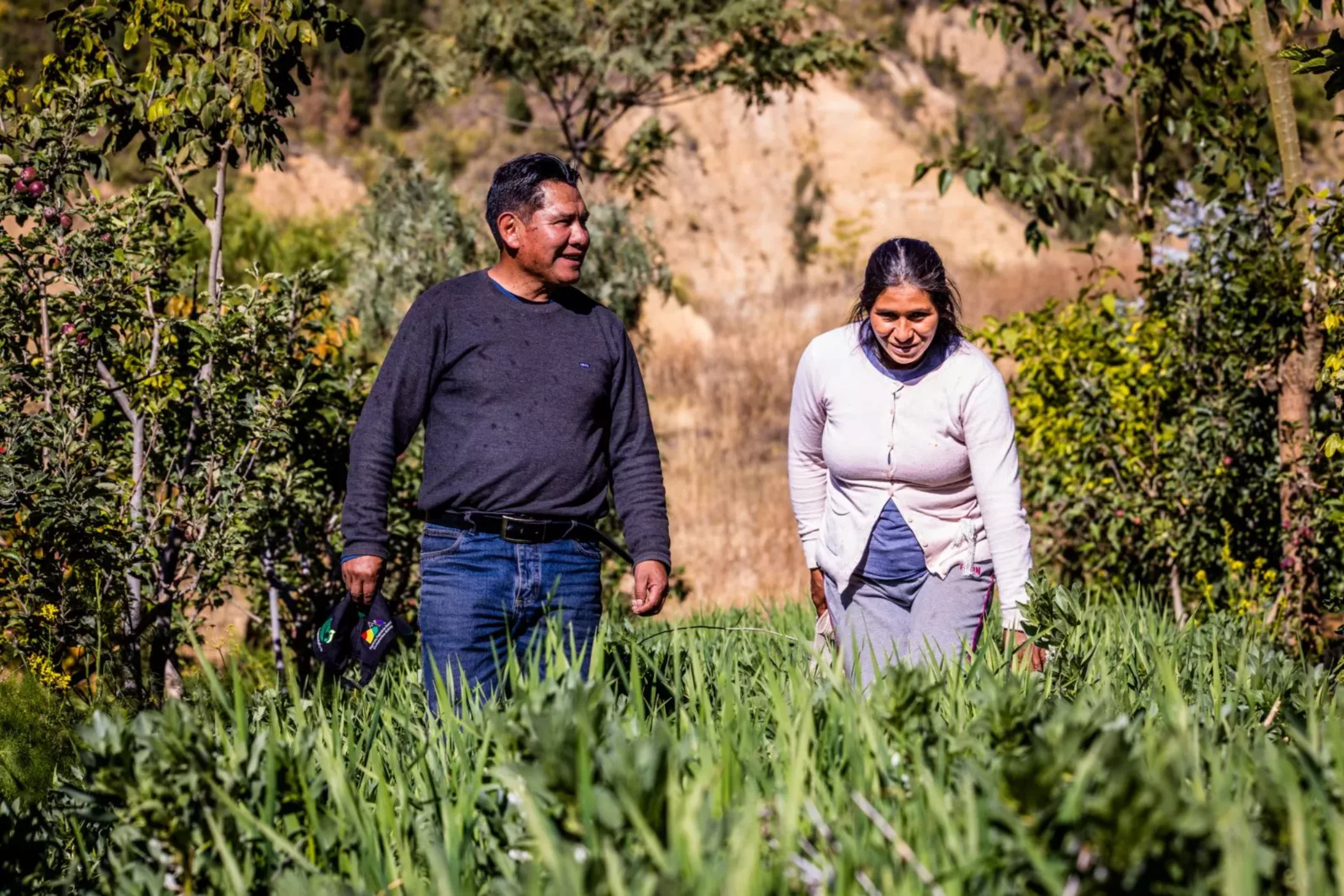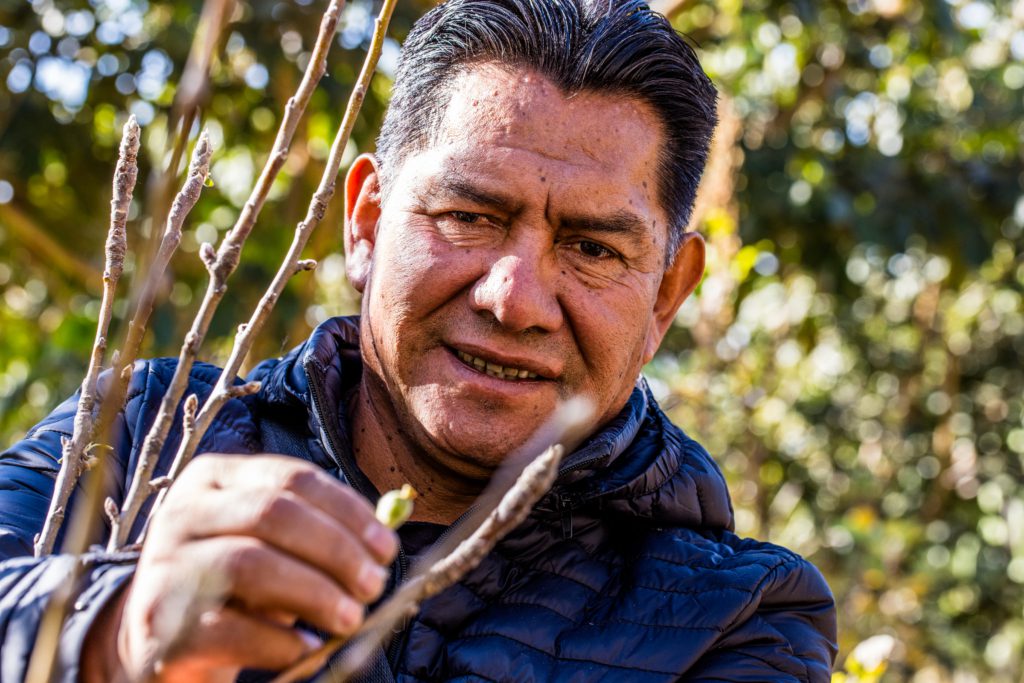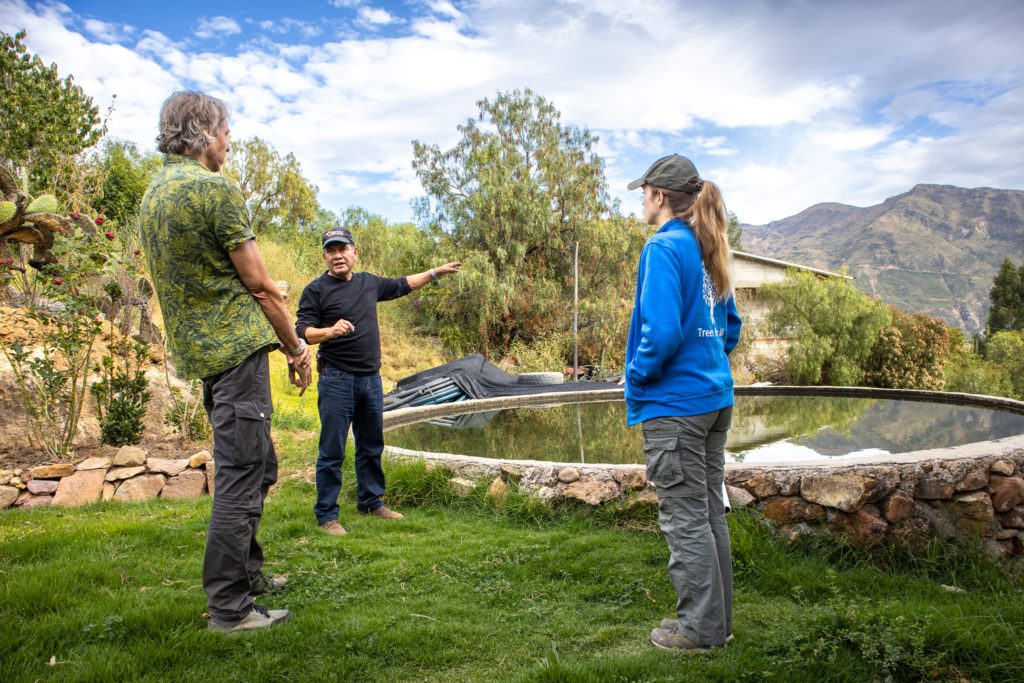Agriculture and nature in balance: this project hero makes it work in Bolivia
15 May 2025

15 May 2025
A successful tree-planting or reforestation project requires guts and perseverance. In our series ‘Project heroes’ we speak with the people who are the driving forces behind projects supported by us. What moves them to go for the planting of trees under highly challenging circumstances? This time: German Vargas (62), Bolivian Andes reforestation project coordinator.
While we are visiting our project in the mountains up near La Paz, something special happens. German, who is showing us around the various planting locations, gets a floral wreath hung around his neck on behalf of the village community, a Thank You for all the positive changes he has brought about over the past few years and the results of which we are now seeing in front of us: young forest plantation on the slopes, reservoirs filled with water and orchards full of crops where first there was only barren soil.
The reforestation and agroforestry project has brought new life to this part of the Andes. German reacts immediately: “You guys ought to thank yourselves. You believe in it and it’s you who have done all the work.” It is illustrative of the modesty of the man who has made out a case for harmonious relationships between humans and nature for over forty years.

German Vargas helps local communities in Bolivia get started with reforestation and agroforestry.
German runs from pillar to post coordinating the project and teaching workshops to the local population. He is himself a resident of Cochabamba, the city in the heart of Bolivia. In his childhood it was a green oasis, but now the city is bursting at the seams as a result of the influx of migrants from the Andes. Because of long-term drought, many country families seek refuge here.
The city has districts that get their water delivered in tankers. “That used to be different”, says German. “There were springs all over the place, the soil was fertile and it rained all year round, be it in small amounts at times.” The forests along the slopes in which German used to play as a kid, have been gone a long time.
The deterioration of the Andes and the climate change had already got underway when German started out at university. Motivated by childhood memories and his parents’ rural background, he opted for agricultural science. That turned out a cold shower. “We learnt how to drive a tractor and spray pesticides. I wondered why out loud. That poison and those tractors are totally unsuitable to our region.”
Heavy erosion in the Bolivian Andes.
Right after finishing his study German filed a proposal with the United Nations. Around Cochabamba they had set up reforestation projects with fast-growing trees from elsewhere in the world, such as eucalypt and fir, exclusively aimed at timber production. But German wanted to work with types of trees that are natural here and contribute to restoring the soil.
The project consented. The first baby trees of local sorts were planted in farmers’ grounds, but that turned out a gigantic failure. “As opposed to eucalypt, the farmers couldn’t care less. They tended to see these trees rather as weed and allowed cattle to chew them. In less than no time, all plantation disappeared.”
Yet German was not to be discouraged. He maintained that the solution lay in nature. It could only be done by combining agriculture with trees of local origin, without either pesticides or fertilizers.. in 21013 he met Menno Staarink, founder of the Samay Foundation, our present project partner. Samay was combatting poverty and was applying itself to ecological projects. German received support to get to work on forest farming.
In practice, this boiled down to: planting crops as livelihood for the families themselves, fruit trees for the market and indigenous trees among these in order to improve micro-climate and soil. But planting those local trees still met with resistance among farmers, since they did not render direct income, was their idea, whereas they required the necessary maintenance.
The big turnabout presented itself with the acquisition of a mountain farm situated on a hectare and a half of ground. German: “Time and again I had to convince farmers to plant indigenous trees as well. If they didn’t want to, what could I do? They owned the land, didn’t they?” And so he started to work on the ground he had achieved with a team of his own and showed them that reforestation and agroforestry do have a fair chance of succeeding.

German on the model farm, where thousands of visitors each year receive demonstrations on tree planting and water reservoir construction (in the background).
Within three years they realized a complete food forest. Now all year round crops such as broad beans, corn and potatoes can be seen. The trees are laden with fruit, among which apples, pears and peaches and among these grow indigenous types of trees such as molle and kewiña. A basin of water has been simulated and water is collected in large reservoirs, made of cheap raw materials. The farmhouse has been transformed into an educational center. “Telling is one thing, but practice is the more important thing. Participants themselves learn to plant, prune trees and experience how easily everything grows and blossoms.”
On a yearly basis, the model farm now attracts more than a thousand visitors who show an interest in the approach. Among them are many farmers, but also government officials and students. However, the increasing interest brings with it nasty phone calls from the side of agro-industry. “They shout that I’m ruining their market, though all I want to do is show the world that agriculture may be practiced in harmony with nature.”
Now and then German succeeds in persuading people from the sector. “A man came here who sold pesticides. I struck up a conversation with him and asked why he sold stuff that destroys the soil and our health. ”The man got emotional and told me he had cancer. A week later he boarded up his shop and came to see German again. “I’m going to sell biological products”, he said. ”It won’t cure my cancer, but I want to die a dignified death.”
Food forests with a combination of native trees and fruit trees.
It is experiences like these that fill German’s heart with pride. “I feel useful. After forty years of practical experience, people see me as a leader.” But he does not feel in the least as if he has finished learning: together with other NGOs he keeps working towards a trees-and-water-centered approach. “The Andes farmer is always wondering: how can I maintain my family? Water is life and trees make water available.”
Therefore the formula of success is: sowing, storing and harvesting water. Practically this means reforestation of areas high up in the mountains where rainwater collects. Next it is stored in the reservoirs and kept available all year round. The farmers in turn transform their monotonous fields into agroforestry with crops, fruit trees and indigenous trees which are watered from the reservoirs during the dry season.
German has his farm to convince farmers, but the real jobs are done to the remotest corners of the Bolivian Andes. Always by local workers and always at the requests of the villages. Samay provides seedlings, building materials for the reservoirs and necessary support, and the villagers do the rest. It works, especially because of this intrinsic motivation to be able to harvest the fruit from water and trees.
Trees for All has been able to give this approach a boost by financing part of the water reservoirs and, since 2021, making the planting possible of 220,000 trees, both in forest farming and reforestation. The results are encouraging. “The water is returning to the mountains”, German tells us enthusiastically. Planting trees takes care of initial recovery, Mother Nature does the rest. She is wise and resilient.”
Together with the Samay Foundation we apply ourselves to reforestation in the Bolivian Andes mountain range. We support local communities to plant trees in strongly degraded areas in order to combat water shortages in the region. Besides we help farmers on their way to set up agroforestry, in which they plant indigenous trees together with crops. This forest farming is a sustainable alternative to traditional agriculture and thus contributes to less deforestation, more fertile soil and more food security.
Read more